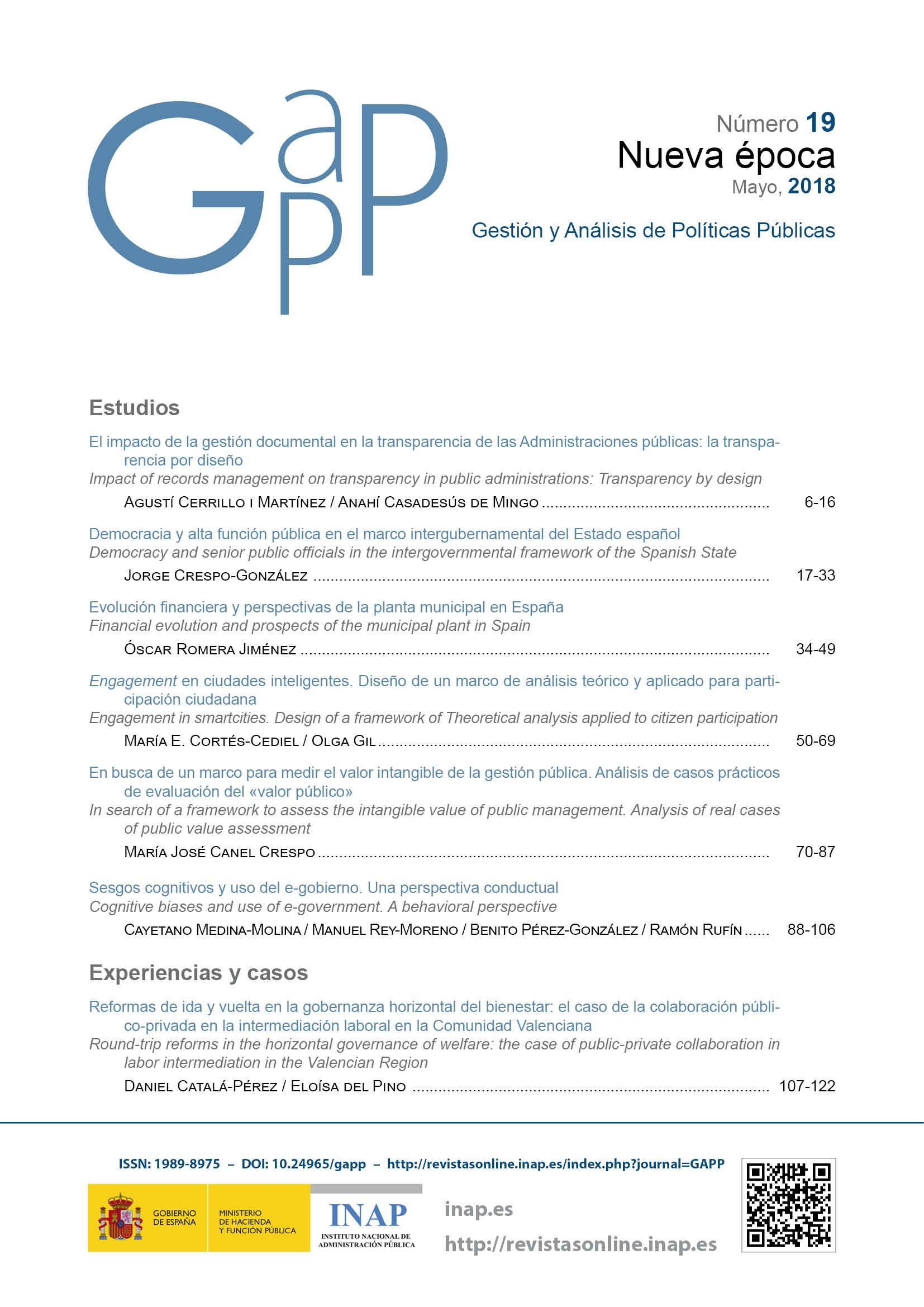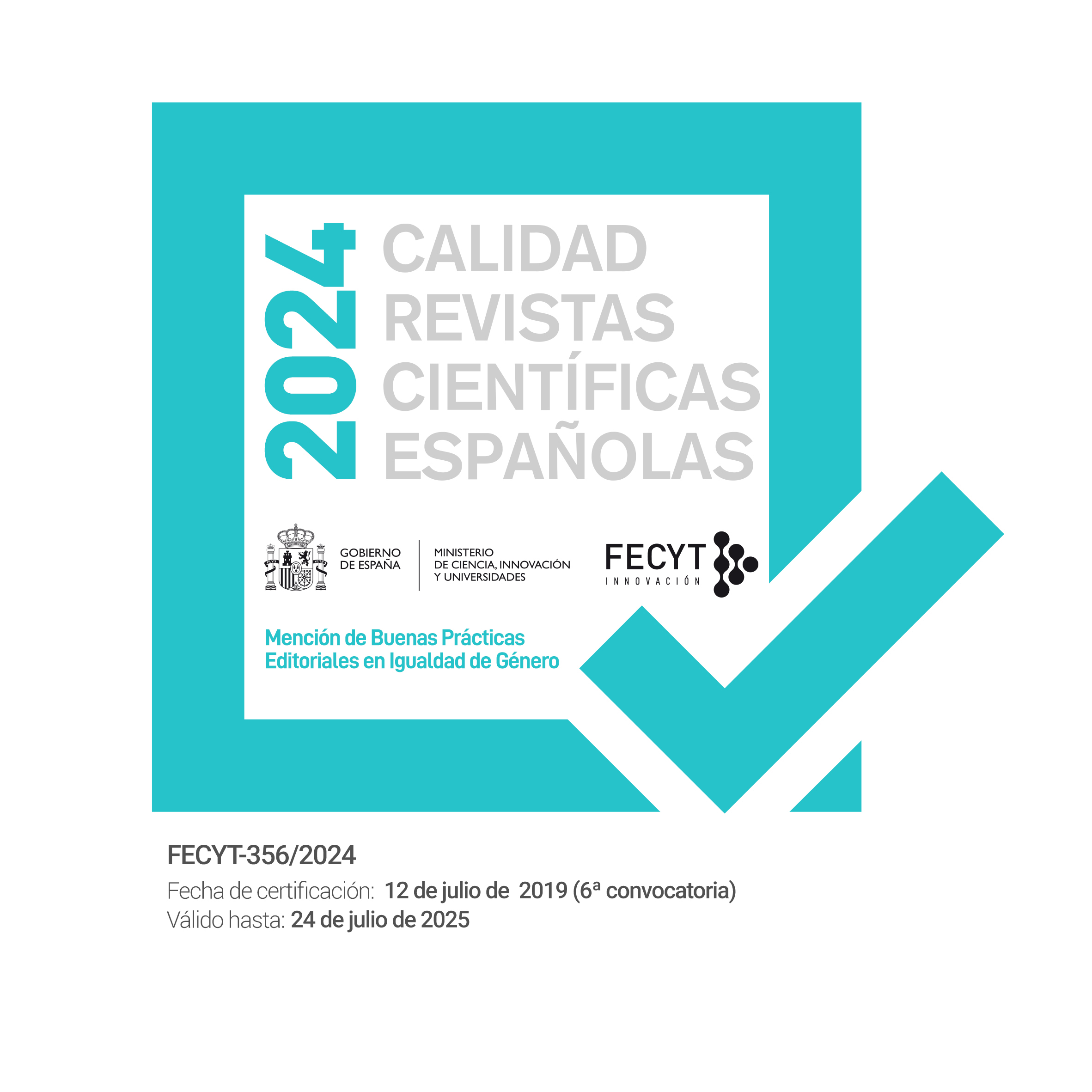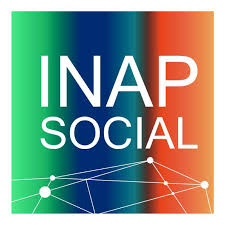Sesgos cognitivos y uso del e-gobierno. Una perspectiva conductual
DOI:
https://doi.org/10.24965/gapp.v0i19.10450Palabras clave:
Administración pública conductual, e-gobierno, hábito, inercia, resistenciaResumen
El e-gobierno se presenta como una herramienta al servicio de la mejora de la eficacia y eficiencia en la prestación de los servicios públicos. Pero, pese a los esfuerzos por lograr una adopción generalizada del e-gobierno, éste presenta unas tasas de uso inferiores a las anheladas. Si bien dicho fenómeno ha sido estudiado desde diferentes perspectivas, en el presente trabajo se presenta la perspectiva conductual como enfoque que responda a tal reto. Para ello, se analiza la relación entre diferentes sesgos cognitivos vinculados a la tendencia del statu quo (hábito, inercia y resistencia) con la intención (de uso para los usuarios y de continuación para los usuarios). Los datos fueron captados tras un trabajo cualitativo (dos sesiones de grupo) y un trabajo cuantitativo (923 cuestionarios), dirigido a dos muestras diferentes de ciudadanos (no-usuarios y usuarios del e-gobierno). Los resultados constatan la presencia de la tendencia al statu quo en el uso del e-gobierno. Mientras en el caso de los no-usuarios del e-gobierno se encuentran presentes los sesgos cognitivos analizados, llevando a dilatar su uso, entre los usuarios del e-gobierno carece de relevancia el hábito, por lo que se mantienen en su uso como canal de acceso a los servicios públicos.
Descargas
Citas
AGENCIA DE EVALUACIÓN Y CALIDAD (AEVAL). (2016). Estabilidad y mejora en los servicios públicos. Ministerio de Hacienda y Administración Pública.
ANDERSON, C. J. (2003), “The Psychology of Doing Nothing: Forms of Decision Avoidance. Results from Reason and Emotion”, Psychological Bulletin, 129 (1): 139-167. DOI: https/doi.org/10.1037//0033-2909.129.1.139.
ARIELY, D. (2008). Predictably Irrational: The Hidden Forces That Shapes our Decisions. NY: Harper Collins.
BHATTACHERJEE, A. (2001). “Understanding Information Systems Continuance. An Expectation-Confirmation Model”. MIS Quarterly, 25 (3), 351-370. https://doi.org/10.2307/3250921.
BHATTACHERJEE, A. y Hikmet, N. (2007), “Physicians’ resistance toward healthcare information technology: A theoretical model and empirical test”, European Journal of Information Systems, 16: 725-737. https/doi.org/10.1057/palgrave.ejis.3000717.
BHATTACHERJEE, A. y LIN, C.-P. (2015), “A unified model of IT continuance: three complementary perspectives and crossover effects”, European Journal of Information Systems, 23: 364-373. https/dx.doi.org/10.1016/j.emj.2011.11.003.
BHATTACHERJEE, A. y PARK, A. C. (2014), “Why end-users move to the cloud: a migration-theoretic analysis”, European Journal of Information Systems, 23: 357-372. https://doi.org/10.1057/ejis.2013.1.
CASTELNOVO, W. y SORRENTINO, M. (2017), “The digital government imperative: a context-aware perspective”, Public Management Review, article in press. https://doi.org/10.1080/14719037.2017.1305693.
CHOUEIKI, A. (2016), “Behavioral Insights for Better Implementation in Government”, Public Administration Review, 76 (4): 540-541. https://doi.org/10.1111/puar.12594.
DATTA, S. y MULLAINATHAN, S. (2014), “Behavioral design: a new approach to development policy”, Review of Income and Wealth, 60 (1): 7-35. https://doi.org/10.1111/roiw.12093.
DWIVEDI, Y. K., RANA, R. P., JANSSEN, M., LAL, B. WILLIAMS, M. D. y CLEMENT, M. (2017), “An empirical validation of a unified model of electronic government adoption (UMEGA)”, Government Information Quarterly, 34: 211–230. http://dx.doi.org/10.1016/j.giq.2017.03.001.
EBBERS, W. E. y VAN DIJK, J. A. G. M. (2007), “Resistance and support to electronic government, building a model of innovation”, Government Information Quarterly, 24: 554-575. https://doi.org/10.1016/j.giq.2006.09.008.
FALK, T., SCHEPERS, J., HAMMERSCHMIDT, M. y BAUER, H. H. (2007), “Identifying Cross-Channel Dyssinergies for Multichannel Service Providers”, Journal of Service Research, 10 (2): 143-160. https://doi.org/10.1177/1094670507306683.
GRIMMELIKHUIJSEN, S., JILKE, S., OLSEN, A. L. y TUMMERS, L. (2016), “Behavioral Public Administration: Combining Insights from Public Administration and Psychology”, Public Administration Review, 77 (1): 45-56. https://doi.org/10.1111/puar.12609.
GRUNE-YANOFF, T. y HERTWIG, R. (2016), “Nudge Versus Boost: How Coherent are Policy and Theory?”, Minds and Machines, 26 (1-2): 149-183. https://doi.org/10.1007/s11023-015-9367-9.
HAIR, J. F., RINGLE, C. M. y SARSTEDT, M. (2011). PLS-SEM: Indeed a Silver Bullet. Journal of Marketing Theory and Practice, 19 (2), 139-151. https://doi.org/10.2753/mtp1069-6679190202.
HSIEH, P. J. y LIN, W. S. (2017), “Explaining resistance to system usage in the PharmaCloud: A view of the dual-factor model. Information & Management”. Article in press. http://dx.doi.org/10.1016/j.im.2017.03.008.
HSIEH, P.-J. (2016), “An empirical investigation of patients` acceptance and resistance toward the health cloud: the dual factor perspective”, Computers in Human Behavior, 63: 959-969. https://doi.org/10.1016/j.chb.2016.06.029.
JILKE, S., VAN DE WALLE, S. & KIM, S. (2016). Generating Usable Knowledge Through an Experimental Approach to the Public Administration. Public Administration Review, 76 (1), 69-72. https://doi.org/10.1111/puar.12488.
KAHNEMAN, D., KNETSCH, J. L. y THALER, R. H. (1991), “Anomalies: The Endowment Effect, Loss Aversion, and Status Quo Bias”, Journal of Economic Perspectives, 5 (1): 695-707. https://doi.org/10.1257/jep.5.1.193.
KHEDHAOURIA, A., THURIK, R., GURAU, C. y van HECK, E. (2016), “Customers’ Continuance Intention Regarding Mobile Service Providers: A Status Quo Bias Perspective”, Journal of Global Information Management, 24 (4): 1-21. https://doi.org/10.4018/jgim.2016100101.
KIM, H.-W. y GUPTA, S. (2012), “Investigating Customer Resistance to Change in Transaction Relationship with an Internet Vendor”, Psychology & Marketing, 29 (4): 257-269. https://doi.org/10.1002/mar.20519.
KIM, H.-W. y KANKANHALLI, A. (2009), “Investigating User Resistance to Information Systems Implementation: A Status Quo Bias Perspective”, MIS Quarterly, 33 (3): 567-582. https://doi.org/10.2307/249384.
LEE, K. y JOSHI, K. (2016), “Examining the use of status quo bias perspective in IS research: need for re-conceptualizing and incorporating biases”, Information Systems Journal. https://doi.org/10.1111/isj.12118.
LI, Z. y CHENG, Y. (2014), “From free to fee: exploring the antecedents of consumer intention to switch to paid online content”, Journal of Electronic Commerce Research, 15 (4): 281-299.
LIMAYEN, M., HIRTZ, S. G. y CHEUNG, C. M. K. (2007), “How habit limits the predictive power of intention: the case of information systems continuance”, MIS Quarterly, 31 (4): 705-737. https://doi.org/10.2307/3250921.
LUNA-REYES, L. F., HERNÁNDEZ GARCÍA, J. M. y GIL-GARCÍA, J. R. (2009), “Hacia un modelo de los determinantes de éxito de los portales de gobierno estatal en México”, Gestión y política pública, 18 (2): 307-340. Disponible en web: http://www.scielo.org.mx/scielo.php?script=sci_arttext&pid=S1405-10792009000200003.
MAIO, G. R., VERPLANKEN, B., MANSTEAD, A. S., STROEBE, W., ABRAHAM, C., SHEERAN, P. y CONNER, M. (2007), “Social psychological factors in lifestyle change and their relevance to policy”, Social Issues and Policy Review, 1 (1): 99-137. https://doi.org/10.1111/j.1751-2409.2007.00005.x.
MEDINA, C., RUFIN, R. y REY, M. (2013), “La Adopción Del E-Gobierno En Entornos Voluntarios”, Investigaciones Europeas de Dirección y Economía de la Empresa, 19 (1), 42-52. http://dx.doi.org/10.1016/j.iedee.2012.10.001.
MEDINA, C. (2017). Estrategia omnicanal en la distribución de servicios públicos. Madrid: Instituto Nacional de la Administración Pública.
MEDINA-MOLINA, C., REY-MORENO, M. y PÉREZ-GONZÁLEZ, B. (2017), “Estrategia omnicanal para no usuarios del e-gobierno”, GAPP, 18 (noviembre): 94-109. https://doi.org/10.24965/gapp.v0i18.10463.
MORAES, C., CARRIGAN, M. y SZMIGIN, I. (2012), “The coherence of inconsistencies: Attitude–behaviour gaps and new consumption communities”, Journal of Marketing Management, 28 (1-2): 103-128. https://doi.org/10.1080/0267257x.2011.615482.
MOYNIHAN, D. P. y LAVERTU, S. (2012), “Cognitive biases in governing: Technology preferences in election administration”, Public Administration Review, 72 (1): 68-77. https://doi.org/10.1111/j.1540-6210.2011.02478.x.
MUNUERA, M. P. (2016), “Agenda digital: e-Servicios sociales”, Gestión y Análisis de Políticas Públicas, 16 (julio-diciembre): 27-40. https://doi.org/10.24965/gapp.v0i16.10362.
NG, E. H. y KWAHK, K. Y. (2010), “Examining the determinants of Mobile Internet service continuance: A customer relationship development perspective”, International Journal of Mobile Communications, 8 (2): 210-229. https://doi.org/10.1504/ijmc.2010.031448.
NYGREN, K. G., AXELSSON, K. y MELIN, U. (2014), “Multi-Channel Service Management in Public Sector – Three Interpretative Frames Illustrating E-government and Work Practice in a Swedish State Agency”, Electronic Journal of e-Government, 12 (1): 115-128. Disponible en: http://www.ejeg.com/volume12/issue1.
OECD (2015), Behavioural insights and new approaches to policy design. The views from the field. Summary of an international seminar. Paris, 23 January 2015. Disponible en: https://www.oecd.org/gov/behavioural-insights-summary-report-2015.pdf.
OECD (2017), Behavioural Insights and Public Policy: Lessons from Around the World, OECD Publishing, Paris. http://dx.doi.org/10.1787/9789264270480-en.
OLSEN, S. O., TUDORAN, A. A., BRUNSO, K. y VERBEKE, W. (2013), “Extending the prevalent consumer loyalty modelling: the role of habit strength”, European Journal of Marketing, 47 (1-2): 303-323. https://doi.org/10.1108/03090561311285565.
ONTSI (2017). Indicadores destacados de la Sociedad de la Información.
ORTIZ DE GUINEA, A. y MARKUS, M. L. (2009), “Why break the habit of a lifetime? Rethinking the roles of intention, habit, and emotion in continuing information technology use”, MIS Quarterly, 33 (3): 433-444. Disponible en: http://www.misq.org/contents-33-3/.
PATSIOTIS, A., HUGHES, T. y WEBBER, D. J. (2013), “An examination of consumers’ resistance to computer based technologies”, Journal of Service Marketing, 27 (4): 294-312. https://doi.org/10.1108/08876041311330771.
POLITES, G. L. y KARAHANNA, E. (2012), “Shackled to the Status Quo: the inhibiting effects of incumbent system habit, switching costs, and inertia on new system acceptance”, MIS Quarterly, 36 (1): 21-42. Disponible en: http://www.misq.org/contents-36-1/.
PONT, J. (2016), “Modelos innovadores de administración y gestión pública: Hacia la emergencia de nuevos paradigmas”, Gestión y Análisis de Políticas Públicas, 16 (julio-diciembre). https://doi.org/10.24965/gapp.v0i16.10364.
ROLDÁN, J. L. y SÁNCHEZ-FRANCO, M. J. (2012). “Variance-based Structural Equation Modeling: Guidelines for Using Partial Least Squares in Information Systems Research”. En MORA, M. et al. (Eds.) Research Methodologies in Engineering of Software Systems and Information Systems: Philosophies, Methods and Innovations. Hershey, PA: IGI Global. (Chapter II.3).
SAMUELSON, W. y ZECKHAUSER, R. (1988), “Status Quo Bias in Decision Making”, Journal of Risk and Uncertainty, 1: 7-59. https://doi.org/10.1007/bf00055564.
SCHÄFER, M., JAEGER-ERBEN, M. y BAMBERG, S. (2012), “Live Events as Windows of Opportunity for Changing Towards Sustainable Consumption Patterns?”, Journal of Consumer Policy, 35: 65-84. https://doi.org/10.1007/s10603-011-9181-6.
SIMON, H. A. (1955). “A Behavioral Model of Rational Choice”. The Quaterly Journal of Economics, 69: 99-118. https://doi.org/10.2307/1884852.
TAYLOR, S. y TODD, P. (1995), “Understanding information technology usage: A test of competing models”, Information Systems Research, 6 (2): 144-176. https://doi.org/10.1287/isre.6.2.144.
TRIANDIS, H. C. (1980), Values, attitudes, and interpersonal behaviour, 27. Lincoln: Nebraska: University of Nebraska Press.
VAN VEENSTRA, A. y JANSSEN, M. (2010), “Migration Strategies for Multi-Channel Service Provisioning in Public Agencies”, Electronic Journal of e-Government, 8 (2): 215-226. Disponible en: http://www.ejeg.com/volume8/issue2.
VENKATESH, V., THONG, J. Y., CHAN, F. K., HU, P. J. H. y BROWN, S. A. (2011), “Extending the two-stage information systems continuance model: Incorporating UTAUT predictors and the role of context”, Information Systems Journal, 21 (6): 527-555. https://doi.org/10.1111/j.1365-2575.2011.00373.x.
VERPLANKEN, B. y AARTS, H. (1999), “Habit, attitude, and planned behavior: Is habit an empty construct or an interesting case of goal-directed automaticity?”, en STROEBE, W. y HEWSTONE, M. (Eds.), European Review of social psychology, 10 (1): 101-134.
VERPLANKEN, B. y WOOD, W. (2006), “Interventions to Break and Create Consumer Habit”, Journal of Public Policy & Marketing, 25 (1): 90-103. https://doi.org/10.1509/jppm.25.1.90.
VIDAL, C. y DELGADO, D. (2017), “La reforma de las Administraciones Públicas y el Estado Social en la crisis económica (2012-2015)”, Gestión y Análisis de Políticas Públicas, 17 (mayo): 40-62. https://doi.org/10.24965/gapp.v0i17.10400.
WANG, Q., SONG, P. y YANG, X. (2013), “Understanding the substitution effect between online and traditional channels: evidence from product attributes perspectives”, Electronic Markets, 23: 227-239. https://doi.org/10.1007/s12525-012-0114-2.
WANG, R. J. H., MALTHOUSE, E. C. y KRISHNAMURTHI, L. (2015), “On the Go: How Mobile Shopping Affects Customer Purchase Behavior”, Journal of Retailing, 91 (2): 217-234. https://doi.org/10.1016/j.jretai.2015.01.002.
WOOD, W. y NEAL, D. T. (2006), “The habitual consumer”, Journal of Consumer Psychology, 19: 579–592. https://doi.org/10.1016/j.jcps.2009.08.003.












